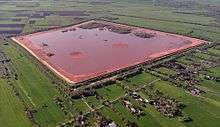Red mud
Red mud or red sludge is a highly alkaline waste product composed mainly of iron oxide that is generated in the industrial production of aluminum. With about 77 million tons of this hazardous material being produced annually, red mud poses a serious disposal problem in the mining industry.[1]
Production and composition
Red mud is a side-product of the Bayer process, the principal means of refining bauxite en route to alumina. The resulting alumina is the raw material for producing aluminium by the Hall–Héroult process.[2] A typical bauxite plant produces one to two times as much red mud as alumina. This ratio is dependent on the type of bauxite used in the refining process and the extraction conditions.[3]
Red mud is composed of a mixture of solid and metallic oxides. The red colour arises from iron oxides, which comprise up to 60% of the mass. The mud is highly basic with a pH ranging from 10 to 13.[2][3][4] In addition to iron, the other dominant components include silica, unleached residual alumina, and titanium oxide.[1]
Use
Many studies have been conducted to develop uses of red mud.[5]
An estimated 2 to 3 million tonnes are used annually in the production of cement,[6] road construction[7] and as a source for iron.[2][3][4][4] Potential applications include the production of low cost concrete,[8] application to sandy soils to improve phosphorus cycling, amelioration of soil acidity, landfill capping and carbon sequestration.[9][10]
Vedanta Aluminium Ltd has commissioned a red mud powder-producing unit at Lanjigarh refinery in Odisha, India, describing it as first of its kind in alumina industry tackling major environmental hazards.[11]
Environmental hazards
Discharge of red mud is hazardous environmentally because of its alkalinity.
In October 2010, approximately one million cubic meters of red mud from an alumina plant near Kolontár in Hungary was accidentally released into the surrounding countryside in the Ajka alumina plant accident, killing ten people and contaminating a large area.[12] All life in the Marcal river was said to have been "extinguished" by the red mud, and within days the mud had reached the Danube.[13]
See also
References
- 1 2 Ayres, R. U., Holmberg, J., Andersson, B., "Materials and the global environment: Waste mining in the 21st century", MRS Bull. 2001, 26, 477. doi:10.1557/mrs2001.119
- 1 2 3 Schmitz, Christoph (2006). "Red Mud Disposal". Handbook of aluminium recycling. p. 18. ISBN 978-3-8027-2936-2.
- 1 2 3 Chandra, Satish (1996-12-31). "Red Mud Utilization". Waste materials used in concrete manufacturing. pp. 292–295. ISBN 978-0-8155-1393-3.
- 1 2 3 Mining, Society for; Metallurgy,; , Exploration U.S (2006-03-05). "Bauxite". Industrial minerals & rocks: commodities, markets, and uses. pp. 258–259. ISBN 978-0-87335-233-8.
- ↑ Kumar, Sanjay; Kumar, Rakesh; Bandopadhyay, Amitava (2006-10-01). "Innovative methodologies for the utilisation of wastes from metallurgical and allied industries". Resources, Conservation and Recycling. 48 (4): 301–314. doi:10.1016/j.resconrec.2006.03.003.
- ↑ Y. Pontikes and G. N. Angelopoulos "Bauxite residue in Cement and cementious materials", Resourc. Conserv. Recyl. 73, 53-63 (2013).
- ↑ W.K.Biswas and D. J. Cooling, “Sustainability Assessment of Red SandTM as a substitute for Virgin Sand and Crushed Limestone”, J. of Ind. Ecology, 17(5) 756-762 (2013).
- ↑ Liu, W., Yang, J., Xiao, B., "Review on treatment and utilization of bauxite residues in China", Int. J. Miner. Process. 2009, 93, 220. doi:10.1016/j.minpro.2009.08.005
- ↑ "Bauxite Residue Management". bauxite.world-aluminium.org. The International Aluminium Institute. Retrieved 9 August 2016.
- ↑ Si, Chunhua; Ma, Yingqun; Lin, Chuxia (2013). "Red mud as a carbon sink: Variability, affecting factors and environmental significance". Journal of Hazardous Materials. 244-245: 54–59. doi:10.1016/j.jhazmat.2012.11.024.
- ↑ "Vedanta commissions red mud powder plant in Odisha". Business Line. 19 November 2013.
- ↑ "Toxic Red Sludge Spill From Hungarian Aluminum Plant 'An Ecological Disaster'", David Gura, NPR, October 5, 2010
- ↑ "Hungarian chemical sludge spill reaches Danube". BBC. 7 October 2010.
External links and further reading
| Wikimedia Commons has media related to Red mud. |
- Red Sludge (or Red Mud) at The Periodic Table of Videos (University of Nottingham)
- Babel, S.; Kurniawan, TA. (Feb 2003). "Low-cost adsorbents for heavy metals uptake from contaminated water: a review". J Hazard Mater. 97 (1–3): 219–43. doi:10.1016/S0304-3894(02)00263-7. PMID 12573840.
